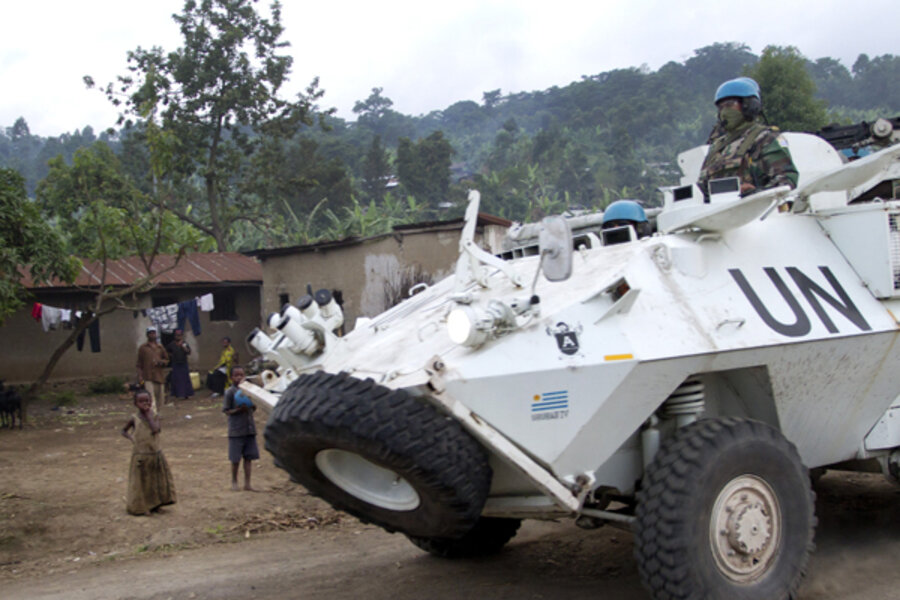Congo Siasa: Congolese troops showing progress against mutiny
Loading...
• A version of this post appeared on the blog "Congo Siasa." The views expressed are the author's own.
The military situation in the Kivus of eastern Congo remains volatile, with fighting continuing throughout the weekend as Congolese army mutineers – now dubbed the M23 movement – have migrated from their Masisi stronghold to the border with Uganda and Rwanda. The potential headlines from this week should include: "Congo army finds new confidence," "a mutiny stands its ground," and "army defections spark tensions between Congo and Rwanda."
Beginning late last week, the mutiny's commander, Gen. Bosco Ntaganda and his officers began leaving the Masisi highlands, traversing the inhospitable brushland behind Nyamulagira volcano and crossing the Goma-Rutshuru road in Kibumba. A large convoy clashed with Congolese army soldiers there on the morning of Tuesday, May 8 before making it to the Rwandan border, which they followed on their way northward, toward Runyoni and Chanzu, hills on the edge of the Virunga national park. The rebels captured these two hills on May 10. There was further fighting there on Saturday and Sunday as the Congolese army deployed several of its newly-acquired attack helicopters. They repelled an attack, but have been unable to re-capture the hills.
The fighting has displaced thousands of people, including over 7,000 people who have fled to Rwanda.
The more reliable estimates of the mutineers' strength range between 300 and 800. For some perspective, that should be compared with the 6,000 soldiers from the CNDP militia that integrated with the army in 2009. The group is officially led by Col. Sultani Makenga, the former deputy commander of military operations in South Kivu. Gen. Bosco Ntaganda's whereabouts are the subject of much speculation - every hour a new rumor pops up - but the mutineers still deny they are collaborating with him.
The Congolese army, on the other hand, has deployed several thousand troops in the area, along with tanks, artillery, and attack helicopters. The United Nations blue helmets, who helped the Congolese army defend against a crucial attack in Masisi last week, are not currently participating in the fighting.
Given the mutineers' position on a small patch of land next to the national park, it is unclear how long they can hold out without supplies of food and ammunition. They were reported to have dug up an arms cache when they first arrived there, which may sustain them. However, unless they are able to conduct raids into the surrounding villages, or establish supply routes through Rwanda, they could soon run out of supplies.
Meanwhile, talks have been ongoing in Rubavu and Kigali between the Congolese and Rwandan governments. The Congolese have been represented by Kalev Mutond (the head of intelligence), Col. Jean-Claude Yav (the head of presidential security), Gen. Didier Etumba (the commander of the army), and the new defense minister, Alexandre Luba. Officially, the talks are only consultations, given the Rwandan government's role in bringing about the integration of ex-CNDP in 2009. The talks have been cordial and have discussed issues such as operations against the FDLR (the anti-Rwandan rebel group, Democratic Forces for the Liberation of Rwanda) and the return of Congolese refugees, but, according to officials present in the talks, there has been little progress on the main issue - the fate of the mutineers.
While both sides are still refraining from any overt accusations, tensions are simmering beneath the surface, as Congo officers grumble about suspected support to the mutineers from across the border, and the Rwandan government points to reports of abuses against Kinyarwanda-speakers by the Congolese army. And yet, the peace deal holds.
– Jason Stearns is the author of the book, Dancing in the Glory of Monsters: The Collapse of the Congo and the Great War of Africa, and the blog, Congo Siasa.







